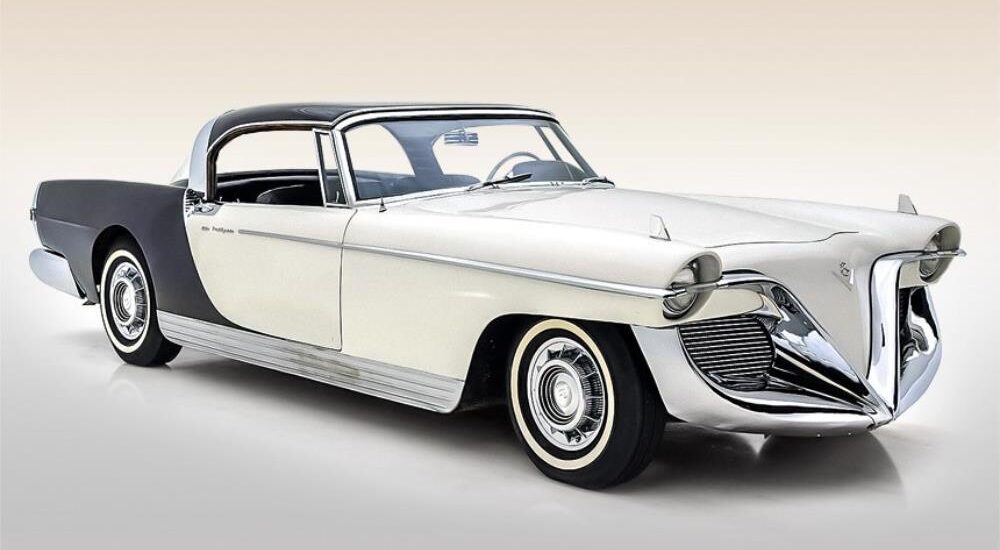«Ebony and ivory Live together in perfect harmony»
Paul McCartney
Rarely do we come across automobiles as unique as the Cadillac Die Valkyrie. In fact, only two of these automotive marvels are known to exist in the entire world. The discovery of the second Die Valkyrie was a recent treasure found hidden away in an American barn in Maryland. While history records that somewhere between five and six of these stunning cars were initially intended, the original plan was nothing short of ambitious – the production of no less than a hundred. Now, let’s delve into the fascinating story behind this extraordinary vehicle.

The car you see in our images today made its grand debut at the 1954 Paris Auto Show, leaving an indelible mark on all who had the privilege of witnessing its magnificence. To put it mildly, the Die Valkyrie is colossal, measuring a breathtaking 6,700 mm from nose to tail. The hood alone stretches a remarkable two meters and forty centimeters in length. And yet, despite its imposing size, it boasts just four seats!
This German-bodied masterpiece, designed in accordance with American principles, left the French automotive enthusiasts in sheer awe. They were unaccustomed to such grand dimensions. To discern its make, one had to closely examine this exceptional vehicle, for it bore no brand emblems on its body. Instead, proud V8 badges adorned both the front and the rear.
Today, it’s easy for any observer to identify this masterpiece by simply glancing at the wheel caps, bedecked with the iconic Cadillac crest. However, back in its Parisian debut, the car sported different wheels – wire-spoked ones, complete with tires featuring a narrow white insert, in stark contrast to its present appearance.

In the front treatment, a grotesque V-shaped motif dominates, gracefully winding around the body with longitudinal moldings. The transparent plexiglass inserts opposite the headlights are supposedly meant to enhance their long-range visibility. The decorative “blades” on the front fenders (also plexiglass) serve as turn signal repeaters, flashing in sync with them.
The visionary responsible for bringing the Die Valkyrie to life was a prominent businessman from Cleveland, known by the suggestive surname of Metzenbaum. He was no ordinary entrepreneur; Metzenbaum was a developer, or in simpler terms, a real estate magnate. He harbored a dream of owning a car that was custom-built to his exact specifications, much like the practices of the 1920s and 1930s, albeit with a modern twist. To turn his dream into reality, Metzenbaum enlisted the services of the renowned American designer, Brooks Stevens.

The front dashboard, steering wheel, and other control components are borrowed from a standard production Cadillac car.
Brooks Stevens was a man of many talents. Over the course of his life, he delved into various fields and excelled in each of them. He’s not a stranger to anyone; we’ve all seen his work—the iconic Miller beer company logo, featuring the distinctive flying cursive, adorning every can and bottle of the beloved frothy beverage.
Stevens, originally an architect by education, graduated from the architecture department of Cornell University in 1933. While his architectural contributions were noteworthy, Stevens was known for his versatility. He undertook projects spanning a wide spectrum of industries, from railroad cars and kitchen furniture to outboard boat motors and Harley-Davidson motorcycles. Among his automotive projects in the mid-1950s, the civilian Jeepsters of the Willys company stood out, particularly the open model, the Jeepster.

Leather seats, according to some reports, were created using springs and other components from Mercedes-Benz 300 (W186) car seats.
When Brooks Stevens took on the Die Valkyrie project, he approached it with the utmost seriousness. For the foundation of this automotive masterpiece, he selected the chassis of a Cadillac Fleetwood 60 Special. The choice was based on its wheelbase of 133 inches, or 3,378 mm. This set it apart, as all other Cadillac vehicles (excluding limousines) at the time had a wheelbase of only 125 inches, equivalent to 3,175 mm.
The Die Valkyrie was designed to have a four-seat interior and an easily removable hardtop. In time, the author even considered a soft folding roof. However, this addition was admittedly quite auxiliary in nature, reserved for those occasional rain showers that might catch you en route.
Early sketches of the Die Valkyrie, dating back to the beginning of 1954, bore the author’s mark, Rapier. Only after Brooks Stevens decided to entrust the realization of his dreams to West Germany’s Spohn atelier did the project receive its thoroughly Wagnerian designation.

The car’s mileage, judging by the odometer, is relatively low, at only about sixty thousand kilometers.
The story of Die Valkyrie is intricately woven with the history of Spohn, the coachbuilding firm that brought it to life. Established in 1920 in Ravensburg, Germany, by Hermann Spohn and Joseph Eiwanger, Spohn initially began as a body repair shop. However, the partners swiftly shifted their focus to crafting custom car bodies. The untimely demise of Spohn in 1923 left Eiwanger to carry on the business solo.
For many years, the renowned Maybach firm from neighboring Friedrichshafen remained a loyal client of the Ravensburg workshop. During the interwar period, Spohn supplied custom bodies for a wide array of car brands, including Bugatti, Opel, Steyr, Hispano-Suiza, Mercedes, Benz, and, starting in 1926, Mercedes-Benz.
Spohn’s creations consistently stood out due to their exceptional craftsmanship, and Joseph Eiwanger evolved into a top-notch stylist who fearlessly embraced streamlined designs. One of his most remarkable achievements was the aerodynamically sound Maybach, developed in collaboration with Professor Paul Jaray. This car created quite a stir at European exhibitions in 1935, wherever it was showcased.
The onset of World War II in 1939 swiftly saw the Nazi military machine taking over Spohn, monopolizing its operations for military equipment production. Custom car bodywork had to be put on hold for an extended period. Only with the return of peace to German soil could the company revive its automotive pursuits, mainly focusing on the restoration of military vehicles for the occupying forces. At this point, Joseph Eiwanger had retired, leaving his son, Joseph Jr., in charge. It was Joseph Jr. who steered the family company back into the realm of bodywork after the German currency reform in 1948.

The interior door trim is rather intricate in design.
The timing for such a return was far from ideal. Orders for custom car bodies from European nobility had nearly evaporated, and the traditional clientele had vanished. So, Joseph Jr. targeted servicemen from the occupying forces. Given that Ravensburg was situated in the American sector by this time, his gamble paid off. By customizing cars of various makes and models for American soldiers and officers, he became the first in Germany to work with the innovative material of fiberglass, reaping substantial profits.
Regrettably, he lacked his father’s grounding in the “classical” era of car design. As a result, his works often appeared as a bizarre medley of unrelated artistic (and sometimes not-so-artistic) techniques. Nevertheless, these creative endeavors appealed to Americans, and some even carried Joseph Eiwanger’s unique creations home with them after completing their service. It was precisely this knack for inventive design that caught the attention of Brooks Stevens, the renowned American designer.

The engine under the hood of the car is entirely standard, identical to that of any other Cadillac model.
The first Die Valkyrie was promptly dispatched to its client, Metzenbaum, in Cleveland, upon completion. Highly content with the result, Metzenbaum enthusiastically declared his intention to order a hundred more from the German craftsmen, with the plan to sell them at a considerable profit. Meanwhile, the second Die Valkyrie, constructed in tandem with the first, was exhibited at the previously mentioned Paris Auto Show.
Upon the conclusion of the exhibition, Brooks Stevens purchased this second car from Metzenbaum. Metzenbaum’s enthusiasm for mass production had quickly waned, and he presented the car to his beloved wife, Alice. Mrs. Stevens actively and intensively used the car for a period, although eventually, it assumed its rightful place in Brooks Stevens’ collection of rare and exceptional cars.
It is this very car that graces the pages of our illustrations, a testament to its enduring allure. Brooks Stevens continued to make remarkable contributions to the field of car design throughout his career. He was the driving force behind the Excalibur project, which led to the world’s first “replicar,” supported by his elder sons. Stevens also performed a brilliant transformation on the Studebaker Hawk car, aligning it with contemporary fashion. His portfolio includes several other prototypes for the Studebaker company, among them an exotic “station wagon” equipped with a sliding roof, allowing the transportation of upright appliances, such as refrigerators.
***
Brooks Stevens left an indelible mark on the Brazilian Willys passenger cars and played a crucial role in the enduring legacy of the four-door Jeep Wagoneer, which remained in production with minimal changes from 1963 to 1991. His journey concluded in early 1995 when he passed away from a heart attack at the age of eighty-four. A couple of years later, as his heirs began to auction off his esteemed collection, the Die Valkyrie car was acquired by Joe Bortz, a well-known Chicago collector with a penchant for “dream cars from days gone by.” His decision to exhibit the Die Valkyrie at an auction in early September may hint at pressing financial needs.

Photo: Sean Dugan, Hyman Ltd.
This is a translation. You can read an original article here: Cadillac Die Valkyrie 1954 года в рассказе Андрея Хрисанфова

Published January 18, 2024 • 8m to read





